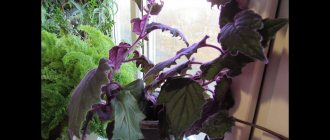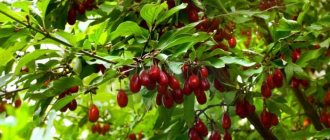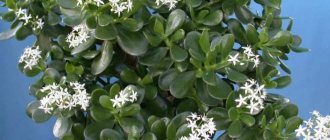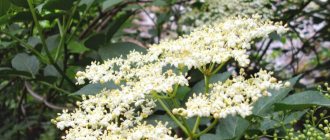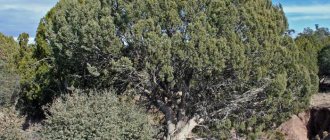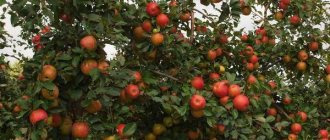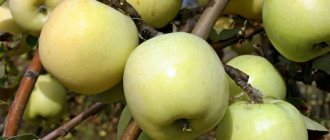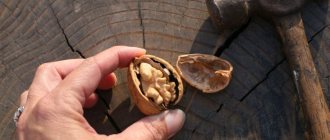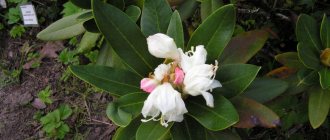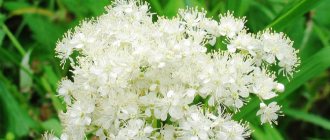Botanical description
Black elderberry is a shrub with a perennial life cycle that sheds all its foliage during its dormant period. The berries are bony, black or purple-black. Despite the fact that the plant is classified as a shrub, with proper care it can grow into a real tree over 7 meters.
It has a rounded crown of regular shape, which is formed by branched stems of brown-gray color (young shoots are green) with a large number of yellowish lentils and large lanceolate leaves of deep green color.
They have an elongated shape, the length reaches 25-30 cm. The bark of the black elderberry has a characteristic brown-ash color.
Blooms in May-June, bears fruit in August-September
Blooms from late spring to early summer. Black elderberry flowers have a beautiful creamy color. At the moment of flowering, the shrub emits a pronounced sweet aroma. The fruiting period occurs in August-September, the berries are large, up to 1 cm in size, and have a sweet and sour taste.
Black elderberry is a non-capricious plant and tolerates a lack of daylight.
Flower formula. *Ch5L(5)T5P5 – regular flower with 5 fused sepals, petals and stamens, with one pistil.
Harvesting workpiece
It blooms in May and July, the fruits ripen in August and September and remain until the leaves fall. Elder flowers are harvested in June and July. The inflorescences are cut and dried under a canopy. The yield of finished raw materials is 12% of fresh ones. Store for up to three years.
Black elderberry berries are cut in clusters and dried a little in the sun. Only ripe fruits are suitable. Dry in dryers at a temperature of 60 degrees. When the berries are dry, sort them out and remove the stems and branches. Store for 6 months.
The leaves are harvested in the spring before flowering. Suitable in dry form for a year.
You may also be interested in: Amur velvet or cork - description, beneficial properties of Amur velvet
The bark is harvested in early spring before the sap begins to flow. Only the top layer is suitable. To preserve its beneficial properties, elderberry bark must be dried very quickly at a temperature of 40 degrees. Store for 3 years.
The roots are collected in the fall, dried and ground to a powder. Healing properties are retained for 5 years.
»»» Use of elderberry for immunity«««
Chemical structure
Elderberry fruits contain:
- glucose;
- fructose;
- free acids (mainly malic acid);
- vitamin C;
- tanning agents.
Dried leaves contain provitamin A.
Black elderberry inflorescences contain:
- mucous substances;
- malic, acetic and valeric acids;
- paraffin-like substance;
- solid essential oil;
- terpene and glucoside;
- having the diaphoretic effect of rutin.
The flowers of this plant have unique properties.
Classification
Representative of the Adoxaceae family. Previously, it was classified in the genus “Honeymacaceae” and was even separated into a separate genus “Elderberry”. Latin name Sambucus nigra L.
Other names:
- basenik;
- elderberry;
- elderflower;
- Sambuca;
- Swiss tea;
- wasteland;
- girlish sambuca.
Black elderberry belongs to a small number of species (400) of the honeysuckle family
Pharmacology
Black elderberry has medicinal properties and contraindications.
Due to its chemical composition, it is widely used in medical practice:
- It has the ability to inhibit inflammatory processes and promotes the regeneration of damaged skin.
- Helps digestion. Stimulates the production of gastric juice, reduces acidity, and has bile and diuretic effects.
- Speeds up metabolism.
- For diseases of the heart and blood vessels.
- Used in the treatment of hepatitis.
- Lowers insulin.
- Prevention of vitamin deficiency, antipyretic, antiphlogistic and expectorant.
- Eating berries is an effective prevention of atherosclerosis, insomnia and frequent headaches.
- Reduces blood pressure.
- Elderberry infusion compresses help with joint diseases.
- Skin problems: acne, dermatitis, pigmentation and acne rashes are solved with the help of elderberry decoction.
- Indications for use are:
- liver and kidney damage;
- the occurrence of peptic ulcer of the stomach and duodenum;
- constipation and bloating;
- high nervous excitability;
- difficulty excreting bile;
- boils, rashes, acne, diaper rash and other skin diseases;
- frequent colds;
- atherosclerosis;
- rheumatic lesions, arthritis, gout;
- inflammation of hemorrhoids;
- high cholesterol;
- increased blood sugar;
- metabolic disorders;
- prevention of tumor formation.
Elderberry has a number of medical restrictions:
- pregnancy and lactation;
- ulcerative enterocolitis;
- chronic forms of gastrointestinal diseases;
- diabetes insipidus;
- individual intolerance;
- Should not be taken by children under 12 years of age.
Dosage forms and doses:
- Syrup. Used to prevent ARVI, dry cough, immunomodulator with a general strengthening effect. It is prepared from berry juice, the freshly squeezed mixture is covered with sugar, the mixture is left to “ferment”, it is recommended to take one spoon 3 times a day for 1 month.
- Juice. It has a high content of vitamin C, it is taken to strengthen the immune system and prevent colds, flu and sore throats, stomach ulcers, and inflammatory processes in the genitourinary system.
- Tincture. Made from flowers and rhizomes. Flower concentrate is used as a diuretic, antiseptic and diaphoretic. If you add it to tea, you will get a wonderful tonic and strengthening balm.
- Extract. This is a concentrated extract, which is a component of many medications. Recommended for the treatment of colds and flu. It strengthens cell walls and prevents viruses from penetrating them.
Elderberry medicinal plant
This gift of nature is often used for medicinal purposes. Most often, black elderberry is used for this (fruits, inflorescences, bark, after drying them), jams are made from them, infused, and powders are made. Very scary and at the same time one of the most serious diseases that it helps to cure - leukemia, all kinds of changes associated with oncology.
Infusions and decoctions made from ingredients extracted from this shrub, thanks to the complex of beneficial substances contained in them, stimulate the immune system and directly destroy cancer cells. This allows them to destroy tumor formations without affecting healthy tissues and organs.
Attention! In order for the treatment to have the desired effect, you need to carefully choose the place where the shrub grows and store it correctly.
In addition to oncology, it is able to overcome a number of other pathological changes:
- Flowers - will cope with flu, sore throat, bronchitis, gout, radiculitis. They are an excellent laxative, antibacterial, and diaphoretic.
- Berries improve the condition of blood vessels, help overcome hepatitis, peptic ulcers (in the initial stages), overcome neuralgia, varicose veins, increase hemoglobin, change the composition of the blood.
- The leaves have a calming effect, are a good antipyretic, and steamed leaves have an excellent effect on boils, burns, and any skin inflammation. They will relieve hemorrhoids and cure burns.
- The bark relieves swelling, improves kidney function, not to mention its positive effect on the immune system, and also improves sleep quality.
Red elderberry, today is in demand only in folk medicine; official medicine does not recommend the use of preparations made from parts of this bush. At the same time, healers successfully use it to combat such ailments as:
- migraine;
- colds;
- ulcers;
- bronchitis;
- menopause
Advice! You can take elderberry and medications containing it only after thoroughly studying the list of contraindications.
Species diversity
Within the genus Sambukus, which includes the black elderberry, it is difficult to make a species classification due to the widespread distribution of the shrub and its morphological diversity.
According to various classifications, the family includes 9-40 different perennial herbaceous plants, bushes, bushes and even trees.
Both wild species (used as medicinal raw materials) and cultivated ornamental varieties are known.
Elderberry Wikipedia benefits and harm
Positive experience:
- Used for medicinal purposes.
- As a source of pollen, nectar (in beekeeping).
- As an ornamental plant.
- As a material for experiments in physics.
- As an excellent tool in the fight against rodents.
- In gardening, as an ornamental plant.
Harm: may be slightly toxic, poisonous.
Interesting fact! Because of its pungent odor, elderberry can repel various pests, animals, and insects.
Regions of growth
It is found in subtropics and temperate climates, in:
- Tunisia;
- Algeria;
- Europe;
- Iran;
- Turkey.
Elderberry grows mainly in Australia and the Azores, in the temperate and subtropical climate zones of the Northern Hemisphere.
Elderberry feels good in Ukraine, the Baltic states, Belarus, Crimea, the Caucasus, in the southwestern regions of Russia and in southern Siberia.
Regions of distribution on the map of Russia
Where does elderberry grow?
Black elderberry is widespread - Western, Central, Eastern Europe, the Caucasus, Asia Minor, the Central Black Earth Region of Russia. Undergrowth of different types of forests, forest ravines, and near roads grows.
Used as decoration for gardens and personal plots. Suitable for creating a landscape in a natural style, fits perfectly into such a garden, looks great. Often planted as a background plant, masking fences and outbuildings.
Grows well in fertile soil, sunny place. In the shade, it loses its decorative effect - the leaves become less bright and attractive. Canadian grows better on loamy soils of medium acidity; calcareous soils are suitable for growing red; it languishes in acidic soils.
It is better to plant in a place protected from the wind on the north side. Needs a moderate amount of moisture and nutrients.
»»» Benefits and harms of red elderberry berries and leaves«»«
Specifics of black elderberry
The plant has a wide range of uses.
Pharmacological use
- Flowers, due to the content of essential oils, rutin and mucus, which can envelop the mucous membranes of the nasopharynx, as well as the presence of tanning substances, are widely used as an antiviral and antiphlogistic agent.
- The leaves, despite the presence of nerve paralytic elements in small quantities, are used as a remedy to counteract inflammatory processes.
- Fruits are a real “storehouse” of vitamins, sugars and organic acids. They contain carotene and rutin, which increase hemoglobin levels and improve the elasticity of small vessels. Natural highly effective laxative.
- Roots and bark. It is a diuretic and expectorant. The bark is a source of vitamin B4, which has atherosclerotic, membrane-protective and sedative effects, normalizes fat metabolism, and helps to lose weight.
Black elderberry bark is a source of vitamin B4
In nutrition
Elderberry water is made from elderberry flowers - a flavoring agent for liqueurs and fortified tinctures. The fruits are used as food coloring in creams, sweets, and wines. Used as a dietary supplement with almond flavor. A seasoning that can replace pepper.
Berries are consumed both fresh and processed. The scope of their application is extensive. This includes confectionery, jellies, winemaking, even vinegar making. Jam is made from the petals. Young leaves are good in salads.
In landscape design
An excellent option for landscaping, creating garden compositions and as a free-standing component of a garden composition. Thanks to its beautiful shape, it looks great in the center of smaller plants. It is bred to shade gazebos, dilute hedges and decorate the coastal zone of ponds.
In cosmetology
Cosmetics with elderberry are known as anti-aging, tonic, and:
- has an antioxidant effect;
- improves skin immunity;
- relieves inflammation, swelling;
- calms;
- tones;
- gives elasticity.
Elderberry in landscape design
Each variety is unique in its own way and can decorate any corner of your garden. It can also grow in partial shade, but in dark-leaved specimens in insufficient light the color may not be intense enough.
In a single landing
The ornamental elderberry is so pretty that it doesn’t need any support at all. It looks impressive both against the background of the lawn and in the stone fill. It remains attractive throughout the growing season and will please the eye in both sunny and rainy weather. Young growths, mature leaves, flowering, and berries are decorative.
Like a hedge
In combination with other crops or on its own, this shrub is capable of forming very spectacular, dense thickets. Thanks to its fast growth rate, it is absolutely not scary to cut it and experiment from year to year, forming either smooth or wavy outlines of your living fence.
In mixborder
In a composition with perennials and other deciduous shrubs, black elderberry, as a rule, plays the role of a spectacular dominant, and acts as a spectacular background plant.
When planting black elderberry in any composition, you can grow it in the form of a bush or form it in the form of a small tree.
The charming umbrella shape of the crown looks unusual. At the base of the plant, space is freed up for planting shade-tolerant perennials and shrubs. For example, medium-growing hydrangeas and low-growing hostas will slightly cover the “legs” of the elderberry and create a composition that will be decorative for most of the season.
Folk remedies
Doctors among the people like to use black elderberry. Its medicinal properties are extensive, so various kinds of medicines are made.
Infusion of flowers for drinking
A balm with an anti-inflammatory and enveloping effect is made from the flowers. It is effective against colds and diseases caused by viruses at high temperatures. Used for tonsillitis, bronchitis. Removes mucus from the bronchi.
For external treatments and in gynecology (douching), flower infusions are used.
Laxative infusion of fruits
For constipation, an infusion of berries is good. You can prepare it from three tablespoons of berries and a glass of boiling water. Leave overnight and take one glass in the morning before meals.
Leaves poultice
Elderberry leaves are known for their anti-inflammatory effect and promote the healing of wounds, both clean and with purulent complications. The steamed leaves are placed on a cloth and applied to the wound.
Treatment of edema with elderberry bark infusions
Black elderberry bark powder helps fight swelling and is also used in the treatment of kidney diseases. The action of the drugs is selective (only on the source of inflammation), without affecting the functioning of the heart, and without increasing blood pressure.
Take the infusion up to four times a day, half a glass. It relieves swelling caused by cardiac disorders.
Uses of elderberries
Vein diseases, hemorrhoids, hepatitis, stomach and duodenal ulcers are treated with freshly squeezed juice or syrup based on it. The syrup relieves severe coughing attacks and helps thin sputum. Used to treat liver diseases and enhance choleretic processes, improves immunity.
Berry extract from fresh fruits is known for its antitumor properties.
Alternative medicine recommends the use of elderberry extracts as a prevention of cancer.
Elderberry syrup
Decoctions from leaves
The leaves are used to make decoctions. The leaves are mixed with sage and steamed with boiling water, one glass is enough. Leave the infusion for one hour, take half a glass per day
How to grow
Rich lands are recommended for breeding, however, in nature it easily takes root both in the shade of the undergrowth and on poor soils. To grow black elderberry on the plot, you need to decide on the amount of gardening work, because a month before it you need to prepare the soil.
Dig a hole a little more than half a meter deep and wide. The top layer of soil is separated and mixed with humus in a 1:1 ratio, and phosphorus-potassium fertilizers are added. At this stage, you immediately need to assemble the fence so that the elderberry does not “scatter” throughout the area.
It is better to use slate or metal sheets. If you plan to form an elderberry into a tree, you will need support.
A black elderberry seedling is lowered onto a loosened layer of soil at the bottom, which has been fertilized with a small amount of mineral-enriched soil, covered with the prepared mixture, compacted and watered.
Elderberry care
How to care in spring
In March, trees and shrubs may suffer from sunburn - the bark becomes very hot under the bright spring sun, and at night there is a sharp cooling. To prevent the consequences of this phenomenon, the trunks and forks of the skeletal branches of elderberry are covered with a layer of lime. If damage caused by rodents in winter is found on the bark, disinfect it with a strong solution of potassium permanganate and cover it with garden varnish.
On warm, fine days, you can start pruning the elderberry, and after that treat the bush with a solution of Nitrafen or Bordeaux mixture against diseases and pests that managed to overwinter in the bark or soil under the bushes and trees. The tree trunk circles are freed from insulating material and last year's leaves. If the winter was snowless and the spring was dry, carry out moisture-recharging watering of the elderberry.
Summer care
After elderberry blooms, the bush is sprayed against pests and powdery mildew.
At the beginning of summer, plants begin to actively grow and form ovaries, so the most important task is to provide the garden with moisture and nutrition. The soil in tree trunk circles must be kept loose and moist. In bushes that are frozen in winter, root growth begins to grow, which must be immediately destroyed before it outstrips the bush itself. To prevent the elderberry from spreading throughout the garden, you can dig old slate around the bush at a distance of one and a half meters and to a depth of half a meter.
In August, elderberries are already beginning to ripen on some bushes, and you should be ready to harvest. At the end of summer, it is necessary to create conditions to prepare the bushes for wintering: a rainy summer can cause secondary growth of shoots, which can only be stopped by removing the mulch from under the bushes and pinching the tops of the growing shoots.
Autumn elderberry care
Caring for elderberries in the fall is preparing them for winter. In September, the elderberry harvest continues, after which sanitary pruning of the bush is carried out. At the end of the month, they dig up the soil in the tree trunk circles, apply fertilizers, and, in dry autumn conditions, carry out pre-winter watering of elderberries. If you are just planning to plant elderberries, dig holes for the seedlings at the end of September and fill them with fertilizers.
- Coriander: cultivation, properties, application
In October, the bushes are treated from pathogenic microorganisms and pests that have settled for the winter in the bark of branches or in the soil under the bush, and trunks and large branches, in order to protect them from winter rodents and spring burns, are whitened with freshly slaked lime or chalk with the addition of copper sulfate and carpentry glue. Tree trunk circles are insulated with peat, humus or dry leaves.
As soon as the snow falls, throw it under the bush - this will be the best protection for the elderberry from frost.
Treatment
Twice a year - in early spring, before buds open, and after leaf fall - elderberry bushes and the soil under them are treated for preventive purposes with a one percent solution of Bordeaux mixture or a two to three percent solution of Nitrafen. They do this in order to destroy fungal infections or harmful insects hidden for the winter in the bark or in the top layer of soil.
Instead of these drugs, you can use a one percent solution of copper sulfate or another drug of similar effect. A seven percent urea solution, if treated with it in the spring, acts not only as a fungicide and insecticide, but also as a nitrogen supplement needed by the plant at this time of year.
Watering
Rainy summers and mulch around the tree trunk, which does not allow moisture to quickly evaporate, can save you from watering elderberries. It is best to mulch the soil around the elderberry bush with compost or rotted manure. In summer with normal rainfall, you will not need to water the elderberry, but in dry, hot times, pour 10-15 liters of water under the elderberry bush once a week. Young plants are watered more often. Do not let the soil under the bushes dry out. After watering or rain, it is very convenient to loosen the soil around the bushes and remove weeds.
Top dressing
In fertile soil, elderberry grows well without fertilizing, but it responds very well to nitrogen fertilizers applied in spring and summer to poor soil. Of the organic fertilizers, elderberry is best accepted by slurry and chicken manure infusion. She is also favorable to urea and complex mineral fertilizers. In autumn, elderberries are not fed.
Reproduction
Parthonogenesis can be carried out using standard methods:
- seeds;
- layering;
- cuttings;
- dividing the bush.
When propagated by seeds, the varietal characteristics of the mother plant are almost never preserved. Therefore, vegetative propagation is recommended.
If you decide to propagate by seeds, you need to sow them in rows at a short distance from each other. Sowing depth is no more than 3 cm.
Propagation of black elderberry by seeds
For the cutting method, the material is prepared in July. The length of the cutting should not exceed 12 cm, have at least two internodes with a pair of upper leaves. Planted in a sand-peat mixture, covered with a plastic cap. In autumn, rooted cuttings can be transplanted into the ground.
Reproduction by layering is a method that gives almost 100% survival rate. Either young or lignified 2-3 year old shoots are used. They are bent into pre-dug grooves and pressed with staples so that the tops remain on the surface. Cover with a mixture of soil and compost.
The division of the bush is carried out in the fall. The overgrown plant is dug up and divided into approximately equal parts. Each part must have developed roots and shoots. All cuts and cuts must be treated with ash. The separated parts are planted in pre-prepared holes.
How to collect, prepare and store
Flowers are collected whole. It is necessary to cut off the entire inflorescence, because at the time of drying, the volume of the product is greatly lost. Dry the material in a well-ventilated room at a constant temperature.
The slow drying process is a guarantee of quality material.
The fruits are picked ripe when they have reached a deep purple color. The conditions for drying fruits are different from drying flowers. It is better to use special dehydrators where you can regulate the temperature.
The elderberry berries dry out greatly, leaving only 15% of the harvested yield. However, not all of the liquid evaporates during drying, which reduces the shelf life of dry berries. They need to be used six months in advance and the fruits must be mixed regularly to avoid spoilage.
Medicine does not use leaves in the preparation of medicines. But people gather at the time of picking flowers. They are laid on a flat surface and placed in a well-lit place to dry. Afterwards they are taken to the shade, where the leaves are dried. The dry product is approximately a quarter of the collected mass.
Elderberry flowers, its berries, young branches, leaves, grains and bark are used as medicinal raw materials.
The bark and roots are used in non-standard medicinal practices, since there is no scientifically proven effectiveness of these materials. Harvesting is done in the spring for the bark and in the fall for the roots.
The collected material is finely chopped and dried at high temperature in a room with good ventilation.
Types and varieties of elderberry with photos and names
As mentioned above, black elderberry is the most popular among gardeners in mid-latitudes. In addition to this plant, about 10 different types of elderberry are cultivated at these latitudes, which will be discussed below.
Blue elderberry
This plant is ornamental. Under natural conditions, it can be found throughout North America, and it prefers to grow in mountain pastures and along the banks of rivers and streams. The tree height of this species does not exceed 15 meters. Sometimes there are also shrubs with thin branches that are red in color when young. The color of the trunks is pale sand. The leaf blades include from 5 to 7 coarsely serrated greenish-blue leaves, which reach a length of about 15 centimeters. The diameter of the corymbose inflorescences is approximately 15 centimeters, they consist of fragrant cream-colored flowers. Flowering lasts approximately 20 days. The fruits have a spectacular appearance, their shape is spherical, and their color is bluish-black, because there is a bluish coating on the surface of the berries. The winter hardiness of this species is below average.
Siberian elderberry
Under natural conditions, this species can be found in the European part of Russia, the Far East, East Asia and Western and Eastern Siberia. This plant prefers to grow in dark coniferous and mixed forests, and they can be found at altitudes of up to 2200 meters above sea level. This ornamental shrub reaches a height of 4 meters and is characterized by average frost resistance.
Herbaceous elderberry
In nature, this species can be found in Belarus, Ukraine, the Caucasus and the south of the European part of Russia; this elderberry prefers to grow along river banks and on rocky screes. The height of such a herbaceous plant reaches 150 centimeters, it emits an unpleasant smell, but it looks very impressive during flowering and fruiting. The fruits form scutes on the tops of the stems. Remember that fresh fruits are poisonous because they contain hydrocyanic acid. In some cases, such a plant is planted around currants, because it can repel bud mites and all harmful butterflies. But it is worth considering that if you later want to get rid of the elderberry, it will be extremely difficult to do, since it has a creeping thick rhizome. Dried flowers of this type have a pleasant aroma; they are often used to sprinkle apples during storage.
Elderberry
In the wild, this species is found in eastern North America, and it prefers to grow in nitrogen-rich, moist soil. This elderberry is highly decorative and is often used for landscaping garden plots. The height of the bush is about 4 meters. The color of the stems is gray-yellow. The length of large leaf plates is about 0.3 m. Slightly convex umbrella-shaped inflorescences reach 0.25 m in diameter, they consist of small fragrant whitish-yellow flowers. The glossy, spherical berries with a dark purple color can be eaten. The species has been cultivated since 1761. Externally, the bush is similar to black elderberry, but this species is more suitable for cultivation in mid-latitudes. Decorative forms:
- maxim - this form is the most powerful of all;
- Acutiloba - an elegant bush with highly dissected leaf plates;
- chlorocarpa - the fruits are green, and the foliage color is greenish-yellow;
- aurea - the foliage is green in summer, and deep yellow in autumn and spring.
Elderberry racemose or red
The homeland of this species is the mountains of Western Europe. This species is represented by a small tree, the height of which does not exceed 500 centimeters, and a deciduous shrub with a dense, ovoid-shaped crown. The length of the imparipinnate leaf plates is about 16 centimeters, they are painted in a pale green color, they consist of from 5 to 7 leaflets, pointed and elongated, on the edge of which there are sharp teeth. The diameter of the lush oblong inflorescences is about 60 mm; they consist of yellow-green flowers. The fruit is a small berry of deep red color. The branches and leaf blades of the plant have an unpleasant aroma. This elderberry looks most impressive during fruiting. Cultivated since 1596. Decorative forms:
- Low . The bush is compact, dwarf.
- Fine-leaved . During opening, the leaf plates are painted purple, they are cut into narrow segments, and this is what accounts for the graceful appearance of the bush.
- Purple . The color of the flowers is pink or purple.
- Yellowish . Yellow berries have orange barrels.
- Dissect-leaved . This variety of elderberry racemosa is most popular among gardeners. Large leaf blades open very early; they consist of 2 or 3 pairs of finely dissected leaves.
- Cirrus . When opening, the serrated leaves are purple in color and are dissected almost to the middle. Popular varieties of this variety:
- Plumosa Aurea - openwork leaf plates are green in the shade, and yellow in the light;
- Sutherland Gold - yellow leaf blades are even more dissected.
Elderberry Siebold
In the wild, this species can be found in the Kuril Islands, the Far East, Sakhalin and Japan. In Western Europe it is cultivated as an ornamental plant. This species is represented by a spreading shrub or tree, reaching a height of 8 meters. The appearance is similar to the red elderberry, but the Zimbold elderberry is more powerful. The composition of the leaf plates includes 5–11 parts. The leaves are about 20 centimeters long and 6 centimeters wide. Compared to red elderberry, the inflorescences are larger, but less dense. Cultivated since 1907.
Black elderberry, the description of which is presented at the beginning of the article, also has several decorative forms:
- Guincho Purple . The height of the bush is 200 cm. Young leaf blades are green, and more mature ones are violet-black; in autumn they acquire a reddish tint. The buds are painted deep pink, the open white flowers have only a slight pinkish tint. The color of the stems is purple. It should be noted that when grown in the shade, the bush will be green all the time, so you should choose a well-lit place for planting it.
- Marginata . The height of the bush is about 250 cm, it is characterized by rapid growth. On the surface of the leaf blades there is a fragmentary border of creamy-silver color.
- Pulverulent . This plant is characterized by slow growth; it has very beautiful leaf plates, on the surface of which there are stripes, spots and streaks of white color.
Most often, decorative forms are less resistant to frost, but they have a more impressive appearance; they are planted in the garden as a tapeworm or in a group with other plants.
